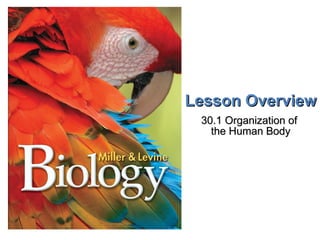Chapter 30.1
•Télécharger en tant que PPT, PDF•
4 j'aime•3,322 vues
The human body is organized at multiple levels, from cells to tissues to organs to organ systems. Cells combine to form tissues like epithelial, connective, nervous, and muscle tissue. Groups of tissues working together form organs like the eye. Organ systems are groups of organs that work together, such as the nervous system. The body maintains homeostasis through feedback inhibition, where a stimulus triggers a response that counteracts the stimulus, keeping conditions stable. Examples include regulating temperature and blood glucose levels. The liver plays an important role in homeostasis by processing toxins, storing and releasing glucose, and regulating blood sugar levels.
Signaler
Partager
Signaler
Partager

Recommandé
Contenu connexe
Tendances
Tendances (20)
Differences between an Animal cell and a Plant cell

Differences between an Animal cell and a Plant cell
B sc biotech i fob unit 1 introduction to biotechnology

B sc biotech i fob unit 1 introduction to biotechnology
En vedette
En vedette (16)
Similaire à Chapter 30.1
Similaire à Chapter 30.1 (20)
Unit I, chapter-1- introduction to human body final

Unit I, chapter-1- introduction to human body final
Chapter 30.1
- 1. Lesson Overview 30.1 Organization of the Human Body
- 12. The organ systems, along with their structures and main functions, are shown below.
- 13. The organ systems, along with their structures and main functions, are shown below.